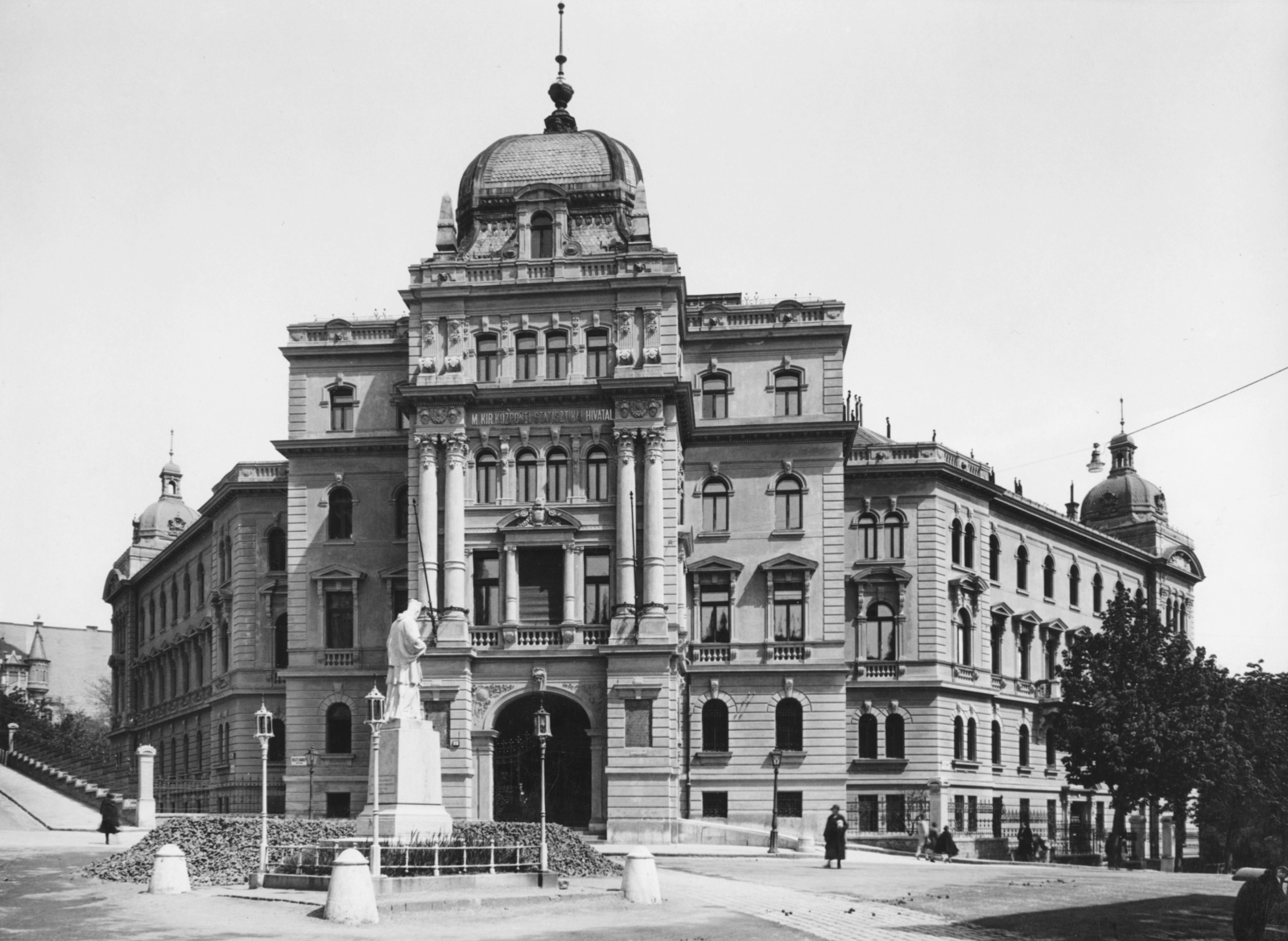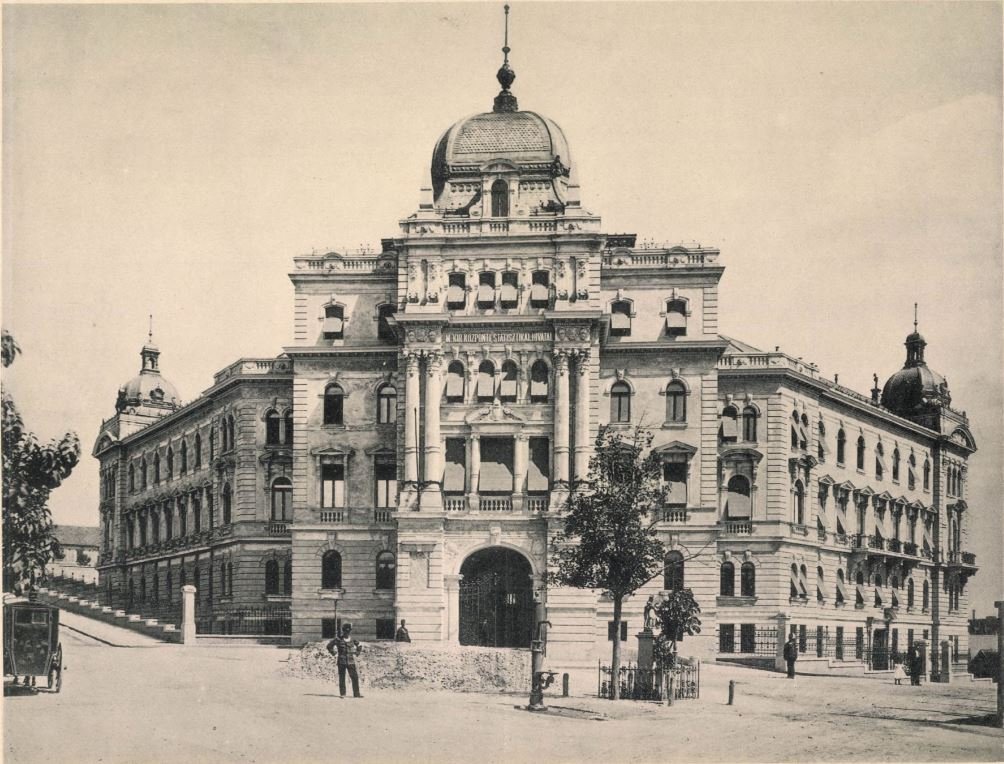Before the establishment of the Central Statistical Office, there were only a few and not entirely reliable statistical data on the social and economic life of Hungarian cities. In 1848, the first responsible Hungarian government established the first Hungarian statistical body within the Ministry of the Interior, but the work could not start due to the events after the war of independence. After the Compromise, which brought economic, spiritual and administrative recovery, it became necessary to organise and set up a statistical office. The statistics department was created within the then Ministry of Agriculture, Industry and Trade, and Károly Keleti was appointed to head it, and he began the work with enthusiasm. Keleti's idea was to have a statistical office in every major city of the country, which would help the central body to obtain even more accurate data.
The headquarters of the Central Statistical Office was built on the site of the former Klemm's brickyard. The 1895 map of the area clearly shows that there were still some buildings on the plot, which were demolished before the construction of the office (Source: Hungaricana)
The statistical department was involved in matters surrounding the 1869 census. After enthusiastic and thorough work, on 18 April 1871, the king approved the organisation of an independent office from the affairs department. It was then that the Hungarian Royal Central Statistical Office was established.
The first legal article on the organisation of statistical matters was published only in 1874. Act 25 briefly summarised the tasks and powers of the recently established authority:
"The management of national statistics, the national collection, processing, compilation and publication of statistical data is carried out by the central statistical office, which is directly subordinated to the Minister of Agriculture, Industry and Trade. The individual ministries also hand over the statistical material belonging to them to the statistical office."
The architect of the headquarters was Győző Czigler, who designed many important buildings in the capital (Source: Iparművészet, Issue 2, 1905)
The next decision was Act 35 of 1897, which confirmed the 1874 decision and summarised the duties of the office in more detail.
"The task of the Hungarian Royal Central Statistical Office is to register the public status of the countries of the Hungarian crown and the public interest relations that change from year to year, and for this purpose to collect as complete and reliable data as possible, to examine, compile, process and publish the data in such a way that they are scientific and they can be used for legislative, governmental, administrative and other practical purposes. For the purpose of comparison, the central statistical office also collects international data, but it is also obliged to promote the interests of international statistics from its own side.
The Central Statistical Office seen from Margit Boulevard in the 9 January 1898 issue of Vasárnapi Ujság. The palace stands out strongly from the surrounding buildings
1897 is significant for the Statistical Office not only because of the published law, but this was when the 2nd District headquarters, which is still its home, was inaugurated. Since its establishment, the institution did not have its own home and was constantly forced to move.
"The state government, appreciating the important services that the well-led and professional statistical institute provides for the country, and taking into account the unfavourable housing conditions in which this office has been housed for many years, in a building converted from an old apartment building on Akadémia Street, decided to build a new building solely for the purposes of the institute"
- said Építő Ipar on 6 April 1899, when it wrote about the new headquarters.
A photograph of the building of the Central Statistical Office in the 9 January 1898 issue of Vasárnapi Ujság
The Minister of Trade found the abandoned Klemm's brickyard site on the Buda side to be the most suitable place for construction, and in the spring of 1896, the papers already informed that negotiations had begun on the purchase of the site. This area was not yet considered a developed area in 1896, since at that time only the Franciscan church and monastery stood out from the buildings in the area. There were villas and vacation homes scattered here, but mostly there were only one-story residential buildings in the streets here. However, the location was not chosen by chance: they wanted to promote the development of Buda by building the headquarters of a state office.
A recording was made of the headquarters of the Statistical Office, which was published in the 28 December 1899 issue of Építő Ipar. The three domes of the building are clearly visible, of which only one remains today
In the spring of 1896, they negotiated the price of the land, and on 5 July, the king gave his nod to the construction of the building. The decision on construction was also confirmed by Act 20 of 1896, which referred to "the building to be erected to house the Hungarian Royal Statistical Office".
The architect and university teacher Győző Czigler (1850–1905) was entrusted with the preparation of the building's plans, who by then had such buildings as the Palace of the Academy of Commerce on Alkotmány Street, the building of the Pest First National Savings Bank on Erzsébet Boulevard, the Saxlehner Palace on Andrássy Avenue or the Rózsák Square Greek Catholic church.

The headquarters of the Statistical Office in a photograph taken in 1940, with the statue of St. John of Nepomuk in front of the building (Source: Fortepan/Nr.: 24148)
It was not an easy task, since the streets connecting the plot, Oszlop Street (today's Keleti Károly Street) and Tudor Street (today's Buday László Street) were very ascending and needed to be arranged. The above-mentioned issue of Építő Ipar informed about the additional conditions to be kept in mind:
"Amidst the prevailing unfavourable conditions, but especially because the cost was limited and because it was necessary to take into account the definite requirement of the given program, first of all, to establish expedient and completely clear official premises, the building should be able to be expanded later, the floor plan was made in a way that the main entrance should reach the space created by the merger of Oszlop Street and Tudor Street, the staircase should be in the middle of the building, in front of the courtyard, and the building wings should be grouped around a large central courtyard."
Work began in October 1896 and was completed by the end of the following year.
The building of the Central Statistical Office nowadays (Source: oroksegnapok.gov.hu)
The building of the Statistical Office from a bird's eye view. The special layout of the building is clearly visible (Source: oroksegnapok.gov.hu)
The building was inaugurated on 18 December 1897 by the then Minister of Trade Baron Ernő Dániel, but the move was not fully completed until January of the following year. On the day of the inauguration, Czigler guided the invited guests through the building.
"Among the 140 rooms, there is not a single courtyard room, wide, bright, closed corridors run around the palace from the spacious courtyard. The official rooms flow from each other in such a way that there is a connection, but at the same time, there is a separation that is so necessary for the undisturbed work. The facade of the palace is occupied by a spacious council room on the first and second floors, while the corresponding room on the third floor is intended for carrying out larger temporary works, for which even the huge, bright staircase and side rooms are very suitable."
– the Vasárnapi Ujság presented the building on 9 January 1898.
In addition to the office premises, the building housed the director's apartment, the servants' apartments, the library and warehouses.
The office's elegant staircase (Source: oroksegnapok.gov.hu)
The library. The office has a huge collection of books (Source: oroksegnapok.gov.hu)
The building was hit by a bomb during World War II, which caused serious damage not only to the building but also to the office's library. During the restoration of war damage, only one of the three domes was restored.
The Central Statistical Office has been operating in the Czigler headquarters since the handover, but it has also acquired other office buildings over time. The Hungarian Demographic Research Institute is located right next to the main building, it operates at 1-3 Buday László Street, and it has offices at 14-18 Fényes Elek Street as well as at 18B Keleti Károly Street.
Cover photo: The photograph taken of the headquarters of the Statistical Office was published in the 28 December 1899 issue of Építő Ipar




































Hozzászólások
Log in or register to comment!
Login Registration